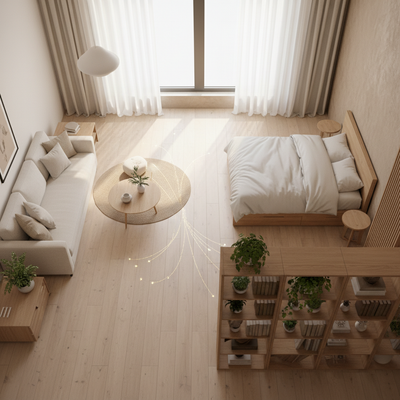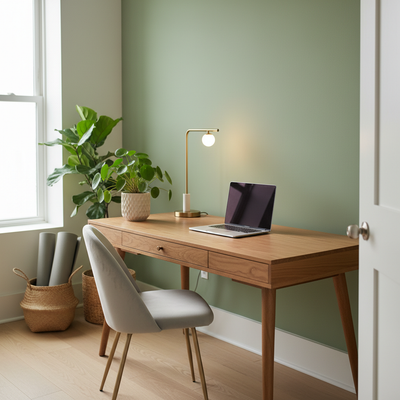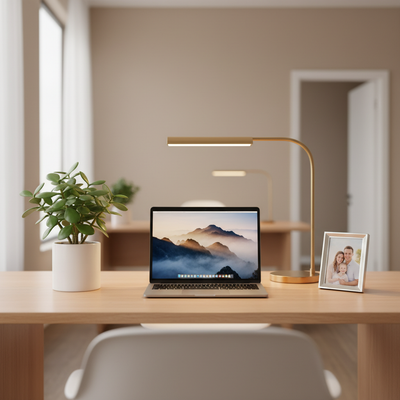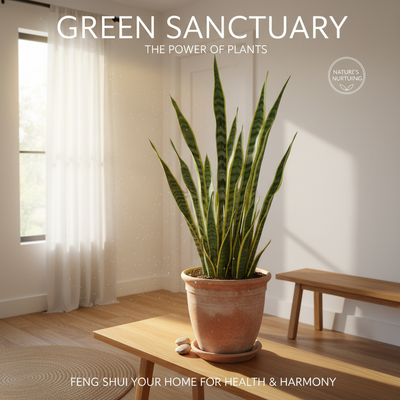Your bedroom should be more than just a place to sleep. It should be your personal safe space, where you can fully recharge, relax, and escape from the outside world. If your bedroom feels more messy than peaceful, you're not alone. The busy pace of modern life often creeps into our most private spaces, making it hard to rest and feel renewed. This is where the ancient practice of Feng Shui can make a real difference.
Feng Shui is the art of arranging your space to work with the natural flow of energy, called Qi. When Qi flows smoothly, it supports your health, happiness, and overall well-being. In the bedroom, this means deeper sleep, better relationships, and a strong sense of peace. While the practice has deep roots, its rules are easy to use. The most important part of a feng shui bedroom layout is the Commanding Position. Learning this one idea can immediately change the energy of your room, making you feel more secure and in control. Let's start there.
The Foundation of Your Safe Space: The Commanding Position

Every good Feng Shui layout starts with understanding and using the Commanding Position. This isn't just about where you put your furniture; it's about positioning yourself with an energy of safety, awareness, and calm control over your own space and, by extension, your life.
What is the Commanding Position?
The Commanding Position is the spot in a room that gives you the greatest advantage and security. For your bed, this means you should be able to see the main door to the room without being directly in line with it.
Why is this so important? From an evolutionary view, our brains are designed for survival. Sleeping with our back to the entrance of our "cave" creates a subtle, unconscious feeling of being unsafe. We cannot see potential dangers or opportunities coming. By placing your bed so you have a clear view of the door, you send a powerful message to your nervous system: "You are safe. You are in control. You can fully relax." This deep sense of security allows your body and mind to give in to healing sleep.
How to Do It
Getting the perfect Commanding Position is a simple process. Follow these steps to check and adjust your bedroom layout:
- Find the main door to your bedroom. This is the primary entrance you use, not a closet or bathroom door.
- Place your bed so that when you are lying down, you are diagonally across from the door. This is the best placement.
- Make sure you have a clear, unblocked view of the door. You shouldn't have to strain your neck or sit all the way up to see it.
- Avoid the "coffin position." This is where your feet point directly out the door while you sleep. This position is considered the worst in Feng Shui as it is said to drain your life force energy away from you.
(For best results, we recommend drawing your room and drawing a line from your pillow to the door to see the best placement.)
What If It's Not Possible?
Not every room has a layout that allows for the perfect Commanding Position. Building constraints are real. If you cannot place your bed in the proper position, there is a simple and effective Feng Shui fix: a mirror.
Place a small, stable mirror in a spot where it reflects the entrance of the door to you while you are in bed. The mirror should be positioned so you can see the reflection of the door easily. This "fix" effectively does the job of your own eyes, allowing you to be energetically aware of the entrance and reducing the unconscious feeling of being unsafe. Make sure the mirror is clean and securely placed.
The 5 Golden Rules of Layout
Once you've set up the Commanding Position, you can improve your bedroom's energy with five additional core rules. Think of these as the essential checklist for creating a truly supportive and peaceful safe space.
1. Use a Solid Headboard for Support
Your headboard represents support and stability in your life, especially in your relationships. A bed pushed against a wall without a headboard can create a feeling of being ungrounded. Choose a solid, one-piece headboard made of wood or one that is padded. These materials provide a strong, supportive energy. Avoid headboards with bars, slats, or holes, as these can create a "cutting" or trapping energy and fail to provide the solid backing you need. The headboard should be securely attached to the bed frame to strengthen that sense of stability.
2. Create Balance with Bedside Tables
Balance is a key idea of Feng Shui. Placing a bedside table on each side of the bed creates this balance, encouraging equality and harmony between the partners who share the bed. Even if you sleep alone, two nightstands create a more complete and balanced energy in the room. They don't have to match, but they should be of a similar height and size to feel balanced. This symmetry provides a stable foundation for your personal energy and relationships.
3. Keep Under the Bed Clear
The space under your bed needs to be open for Qi to flow freely around you as you sleep. When this area is cluttered with storage boxes, old shoes, or forgotten items, the energy becomes blocked and stuck. This can show up as feeling "stuck" in certain areas of your life, restless sleep, or health problems. In our practice, we've seen clients report much better sleep and a feeling of "lightness" after simply clearing out under-bed storage. If you must store items, limit them to soft bedding like pillows and blankets. Avoid storing anything with strong emotional connections or stressful energy, like old letters or work files.
4. Be Careful with Mirror Placement
Mirrors are powerful energy movers in Feng Shui. They bounce and increase energy around a room. While this can be helpful in other areas of the home, it is disruptive in a space meant for rest. The main rule for mirrors in the bedroom is to avoid any placement where they reflect the bed. A mirror reflecting you while you sleep can disturb your energy, leading to sleeplessness or restlessness. It is also said to energetically invite a third party into a relationship, potentially causing problems with cheating or interference. If you must have a mirror in your bedroom, place it on the inside of a closet door or cover it with a beautiful cloth at night.
5. Keep Work Separate from Rest
Your bedroom's main purpose is for rest and intimacy. When you bring work materials, exercise equipment, or a cluttered desk into the space, you introduce an active, Yang energy that conflicts with the calm, Yin energy needed for sleep. The energy of deadlines, stress, and physical effort becomes mixed with your sanctuary, making it difficult to fully switch off. If your living space requires you to have a desk in your bedroom, do your best to create a visual separation. Use a decorative screen, place the desk inside an armoire that can be closed, or at the very least, cover your computer and work materials with a cloth at the end of the day.
Beyond the Textbook: Solving Modern Layout Challenges
Classic Feng Shui texts were not written with modern apartments or uniquely shaped rooms in mind. It's common to face layout challenges that seem to go against the rules. Here are practical, expert-approved solutions for the most common issues.
| Common Challenge | The Feng Shui Problem | The Practical Solution |
|---|---|---|
| Bed Under a Window | A window behind the bed represents a lack of solid support and protection. It can also allow Qi to escape, leading to restless sleep and a feeling of being unsafe. | The best solution is to move the bed. If that's not possible, strengthen the area. Use a very sturdy, tall, solid headboard to create a sense of backing. Install heavy, thick curtains or blinds and be sure to keep them closed at night to create a solid energetic barrier. |
| Slanted Ceiling Above Bed | A low or slanted ceiling directly over the bed creates a constant, heavy energy that can weigh down on you. This can show up as feeling pressured, limited, or can lead to headaches and poor sleep. | Move the bed so that the highest part of the ceiling is above you. If the bed's position is fixed, paint the ceiling a light, bright color to create a visual lift. You can also hang a multi-sided crystal from the lowest point of the slant to help lift and spread the heavy Qi. |
| Exposed Beams Above Bed | Heavy, exposed beams directly over the bed create what is known as "cutting Qi." This sharp, pressing energy can symbolically "cut" into your body as you sleep, potentially leading to health issues in the area of the body that lies beneath it. | The best fix is to position the bed so you are not sleeping directly under a beam. If this cannot be avoided, a classic Feng Shui cure is to hang two bamboo flutes on the beam, with the mouthpieces pointing up in a "V" shape. This is said to lift the heavy energy. |

| Small Room/Limited Options | In a small room, it can feel impossible to achieve the Commanding Position, avoid placing the bed under a window, and maintain a clutter-free space all at once. | In this situation, prioritize. The Commanding Position is most important. Use the mirror cure if you cannot achieve it directly. Next, make sure you have a solid headboard against a solid wall. After that, focus on what you can control: maximize vertical storage to keep floors clear, use a calming color palette, and be strict about decluttering. |
From Theory to Change: A QI FLOW Client Story
Rules are powerful, but seeing them in action is life-changing. It's one thing to read about energy flow; it's another to witness how a few strategic changes can dramatically improve someone's life.
The Problem: A Stuck, Stressful Bedroom
Let's talk about our clients, Mark and Sarah. They came to THE QI FLOW team feeling drained and disconnected. Their bedroom, despite being beautifully decorated with expensive furniture, felt "off." They reported restless sleep, frequent arguments that seemed to start in the bedroom, and a general lack of energy. The room was a source of stress, not a sanctuary.
Our Feng Shui Analysis: Finding Energy Blocks
Upon review of their bedroom layout, our team found three critical energy blocks that were contributing to their issues.
- Their bed was pushed directly under a low, dramatically slanted ceiling, creating heavy energy.
- A large, antique mirror on the opposite wall directly faced the bed, increasing energy and creating a sense of being "watched" at night.
- The space under their bed was packed with old work documents, photo albums from a past relationship, and unused luggage, creating significant energetic stagnation right beneath them.
The Solution: A Strategic Layout Shift
We recommended three simple, no-cost changes based on the fundamental principles of feng shui bedroom layout.
- Reposition the Bed: The most important change was moving the bed. We relocated it to the opposite wall, which was solid and flat. This immediately placed them in the Commanding Position, free from the heavy weight of the slanted ceiling.
- Relocate the Mirror: We had them move the large mirror to the inside of their main closet door. It was still useful for getting dressed but no longer reflected the bed or disrupted the room's calm energy at night.
- Clear the Clutter: We guided them through the process of clearing everything from under the bed. The work documents were filed in the office, the luggage was moved to a storage closet, and the old albums were respectfully stored elsewhere. This created an open, clear space for Qi to flow.
The Result: Restored Harmony and Deeper Sleep
Within a few weeks, Mark and Sarah reported a dramatic shift. They told us they were sleeping more deeply and waking up feeling genuinely rested for the first time in years. They described the room's atmosphere as "calm and supportive," and they felt a renewed sense of connection and peace in their shared space. This story is proof that Feng Shui is not about expensive decor, but about the intentional placement of what you already have to support your best life.
Going Deeper: Using the Bagua Map
Once your layout is optimized, you can add another layer of intention by using the Bagua map. The Bagua is the energy map of your space, derived from the ancient Chinese text, the I Ching. It's a foundational tool that allows you to see how specific areas of your room correspond to specific areas of your life.
What is the Bagua Map?
The Bagua is a grid of nine sections, or "guas." Each gua corresponds to a major life area, such as Wealth & Abundance, Love & Relationships, Health & Well-being, and Career. By overlaying this map on your bedroom, you can identify which parts of the room affect which parts of your life, allowing you to make targeted improvements.
How to Overlay the Bagua
Applying the Bagua map to your bedroom is simple. You don't need a compass for this Western-style application.
- Stand at the main doorway of your bedroom, looking into the room.
- Mentally place a 3x3 grid over the entire floor plan of the room.
- The row of three squares closest to you contains (from left to right): Knowledge & Self-Cultivation, Career & Life Path, and Helpful People & Travel.
- The middle row contains (from left to right): Family & New Beginnings, Health & Well-being (the center), and Creativity & Children.
- The far row, across the room from the door, contains (from left to right): Wealth & Abundance, Fame & Reputation, and Love & Relationships.
(A simple diagram of this grid overlaid on a bedroom floor plan can be an invaluable visual aid.)
Activating Key Bedroom Areas
While all guas are important, a few are particularly relevant to the bedroom. Here is how to activate them:
- Love & Relationships (Far-Right Corner): This is the most important gua in a primary bedroom. To enhance this area, focus on pairs. Use two nightstands, two lamps, and two pillows. Place artwork that shows a happy, loving couple (not a single person). Elements in shades of pink, red, and white are also helpful here. Place a pair of rose quartz crystals to increase loving energy.
- Health & Well-being (Center): The center of your room, the Health gua, is like the heart of the space. It should be kept as open, clean, and clutter-free as possible. This area is associated with the Earth element, so grounding colors like yellow, beige, or light brown are excellent here. A soft, earthy-toned rug can help anchor the energy of the entire room.
- Wealth & Abundance (Far-Left Corner): While not the primary focus of a bedroom, you can subtly activate this area. Place a healthy, living plant with rounded leaves (like a jade plant) here to symbolize growing wealth. A small, beautiful object in a shade of purple or gold can also be an effective enhancement.
Beyond Layout: Essential Harmonious Elements
A perfect layout is the skeleton of your Feng Shui bedroom; these final elements are what give it life and breath. Pay attention to color, light, and decor to complete your sanctuary.
Color Palette
The best colors for a bedroom are those that mimic the range of human skin tones. This palette, from pale ivory and soft beige to rich terracotta and deep chocolate brown, is naturally calming, nurturing, and grounding. These colors create a soothing backdrop for rest. You can use accent colors to activate specific Bagua areas, but the overall feel should be peaceful. Avoid overly bright, stimulating colors like fire-engine red or electric yellow as the main theme.
Lighting
Harsh, glaring overhead lighting creates sharp, aggressive energy. Instead, opt for layered lighting. Use bedside lamps with soft fabric shades to create a warm, inviting glow. A floor lamp in a corner can add ambient light. Installing a dimmer switch on your main light fixture is one of the best investments you can make for your bedroom, as it allows you to control the energy level from bright and functional to soft and relaxing.
Artwork and Imagery
The images you surround yourself with have a powerful unconscious impact. The art in your bedroom should reflect how you want to feel. Choose imagery that is peaceful, happy, and inspiring. Calming landscapes, beautiful abstracts, or photos of you and your partner during a happy time are excellent choices. Avoid images that are sad, lonely, aggressive, or chaotic.
The Five Elements
For ultimate harmony, aim for a balance of all Five Elements: Wood, Fire, Earth, Metal, and Water. You likely already have most of them.
- Wood: Wooden furniture like your headboard, nightstands, or dresser.
- Fire: Candles, lighting, or shades of red/orange in your decor.
- Earth: Earthenware pottery, crystals, or earthy colors like beige and yellow.
- Metal: Metal lamp bases, picture frames, or colors like white, grey, and metallics.
- Water: A mirror, glass objects, or wavy, flowing patterns.
Creating Your Personal Sanctuary
Creating a feng shui bedroom layout is a journey, not a destination. It begins with understanding the powerful impact of the Commanding Position, which sets the foundation for security and rest. It is built upon with the core principles of a solid headboard for support and a clutter-free space for clear energy flow. Ultimately, the goal is not to create a room that looks like it belongs in a magazine, but one that feels deeply supportive and restful to you.
Trust your instincts. Start with one small, manageable change and notice how it feels. Your bedroom is a reflection of you, and by intentionally shaping its energy, you are taking a powerful step toward a more harmonious, rested, and renewed life.







